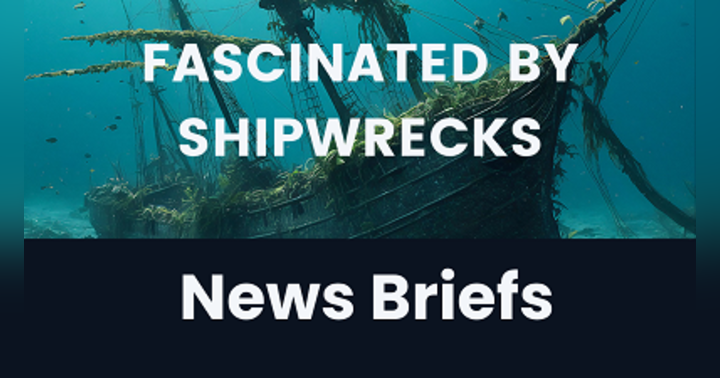Exploring Lost Ships: How Autonomous Tech Is Changing the Game

This somewhat ghostly image shows the individual bathymetric sounding points associated with the USS Saratoga at Bikini Atoll. The view is from off the starboard bow looking back across the deck towards the stern where there is significant collapse of the structure. Credit: Dr. Art Trembanis
On another great Fascinated by Shipwrecks podcast episode, we talked with Dr. Art Trembanis, a marine scientist, coastal geologist, and professor at the University of Delaware. From a childhood spent along the waters of the Pacific Northwest to leading expeditions with cutting-edge underwater robotics, Dr. Trembanis’ story is a compelling journey through the evolving world of ocean exploration.
A Childhood Shaped by the Sea
Growing up near the Puget Sound, Trembanis was surrounded by water, and inspired by it. His heritage, half-Norwegian and half-Greek, combined with a steady stream of National Geographic specials featuring icons like Dr. Bob Ballard, fostered an early fascination with the ocean and its secrets.
“I was always captivated by the sea,” he shared. “Shipwrecks, in particular, drew me in early on. I remember visiting the wreck of the SS Catala as a kid. I was a tactile introduction to maritime history.”
Though he didn’t initially set out to specialize in shipwrecks, his work studying how objects like mines interact with ocean currents eventually led him to collaborate on shipwreck research, including Blackbeard’s famed Queen Anne’s Revenge.
Science, Sensors, and Seafloor Mysteries
Dr. Trembanis describes himself as a coastal geologist and physical oceanographer at heart. His core interest lies in “morphodynamics”—how waves, storms, and currents shape coastlines and the seafloor. This research requires a suite of tools: geophysical sensors, wave trackers, current meters, and increasingly, autonomous robots.
Robotics has revolutionized the field. “We’re only just past the 25% mark in terms of mapping the world’s seafloor,” Trembanis noted. “Autonomous systems—drones, AUVs, ROVs—are giving us a force multiplier to explore deeper, longer, and more efficiently.”
These technologies don’t replace human expertise, they amplify it. Coordinated missions using air, surface, and underwater drones allow scientists to create high-resolution maps and gather data in ways that were once unimaginable.
From Nuclear Craters to Ancient Coastlines
Some of Trembanis’s most memorable expeditions combine logistical creativity with technical prowess. One such trip took his team halfway around the world to Bikini Atoll. There, in partnership with National Geographic’s Drain the Oceans, they mapped the seafloor where the U.S. tested nuclear weapons in 1946.
“Just getting there was an odyssey,” he recalled. “Six and a half days of travel, multiple flights, a four-day steam across open ocean, and only a week to complete the work.”
Their mobile sonar systems had to be mounted on a vessel they’d only seen in pictures before arrival. It was a lesson in adaptability and the importance of cross-disciplinary teamwork.
Another standout moment came aboard the STS Bodrum, a replica of a 19th-century sailing ship. With high school and university students onboard, Trembanis’ team used 21st-century robotics to uncover a 3rd-century BCE shipwreck off the coast of Knidos, Turkey.
“It was like a time tunnel had opened. Ancient ship meets modern tech,” he said.
The Human Side of Deep Exploration
Ocean research is often physically and emotionally demanding. “Grueling, exhausting, and sometimes frustrating,” Trembanis admitted. “There are many days of finding nothing. Just seafloor. And then suddenly, you find something extraordinary.”
The moment of discovery where the data revealed the location and orientation of what turned out to be the SS Choctaw. Credit: Dr. Art Trembanis
He described one such experience in Lake Huron while searching for unknown shipwrecks in Thunder Bay. Days of "mowing the lawn" with sonar running methodical back-and-forth scans finally revealed the wreck of the SS Choctaw, a unique whaleback steamship embedded in the lakebed like a javelin.
“Those moments make all the effort worthwhile,” he said. “And they remind you why collaboration is so vital. Everyone from sonar experts to historians, data analysts to archaeologists, plays a role.”
Educator, Explorer, and Mentor
As a professor, Trembanis finds deep satisfaction in bringing students into this world. Whether in the classroom, on at-sea expeditions, or on study-abroad trips like an upcoming journey to New Zealand, he’s passionate about helping the next generation of marine scientists find their footing.
Students learning about the theory and operation of an autonomous surface vessel (ASV); a robot boat that can conduct surveys especially in shallow waters autonomously. Credit: Dr. Art Trembanis
“There’s a whole ecosystem of roles in this work,” he emphasized. “You don’t have to go to sea to contribute. Archival research, equipment prep, AI data processing; there’s a place for every skillset.”
And for those already in the field? “We’re duty bound to share what we’ve learned,” he said. “We stand on the shoulders of those who came before us. It's our job to mentor those who’ll lead next.”
Want more fascinating stories from the deep?
Catch the full interview with Dr. Art Trembanis on the Fascinated by Shipwrecks podcast. Listen or watch anytime. You'll see more photos in the video version!
© 2025 Fascinated by Shipwrecks








